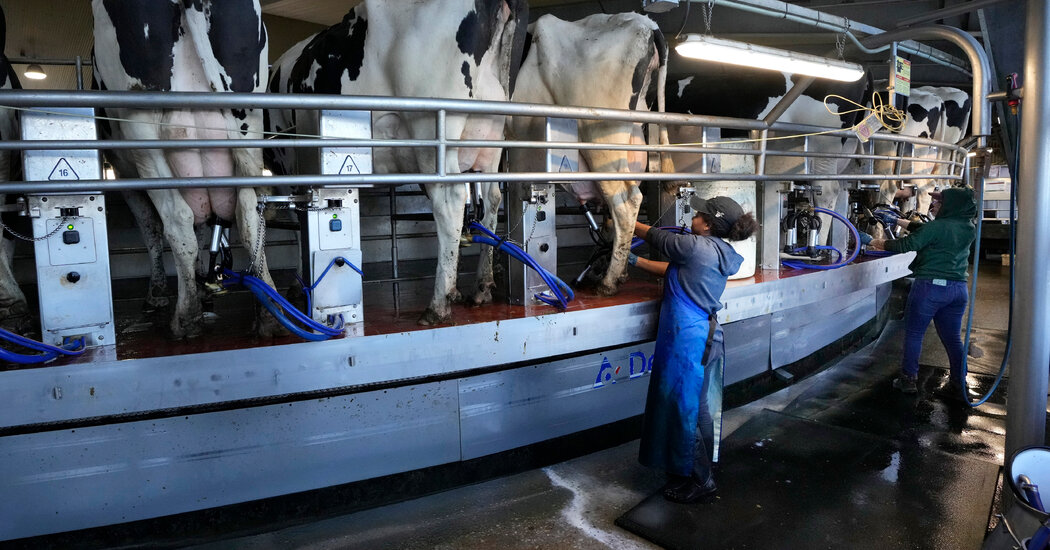
Federal regulators discovered fragments of the avian influenza virus in about 20 percent of retail milk samples analyzed in a nationally representative study, the Food and Drug Administration said in an online update Thursday.
Samples from parts of the country known to have dairy farms infected with the virus were more likely to test positive, the agency said. Regulators have said there is no evidence that this milk poses a danger to consumers or that live virus is present in the milk on store shelves, an assessment that public health experts agree with.
But finding traces of the virus in such a high percentage of samples from across the country is the strongest sign yet that the avian flu outbreak in dairy cows is larger than the official count of 33 infected herds in eight states.
“That suggests there's a lot of this virus out there,” said Richard Webby, a virologist and flu expert at St. Jude Children's Research Hospital.
Dr. Webby said he believes it is still possible to eradicate the virus, known as H5N1, from the nation's dairy farms. But it will be difficult to design effective control measures without knowing the extent of the epidemic, he said.
The findings also raise questions about how the virus managed to escape detection and where else it might be spreading silently. Some scientists have criticized the federal testing strategy as too limited to reveal the true extent of viral spread.
Until Wednesday, when the Department of Agriculture announced mandatory testing of dairy cows moving across state lines, cow testing was voluntary and focused primarily on cows with obvious symptoms.
According to the Centers for Disease Control and Prevention, as of Wednesday only 23 people had been tested for the virus, while 44 people had been monitored after exposure to the virus.
A widespread outbreak among cows would pose a greater risk to farm workers, the dairy industry and public health overall. Sustained spread among cows would give the virus more opportunities to acquire mutations that make it more transmissible among humans.
The FDA provided no details Thursday regarding the number or sources of the samples.
“You should go not just to places where you know there was activity and cows, you want to go to places where at least there hasn't been any reported” bird flu, Dr. Webby said.
Experts believe that the pasteurization process, during which milk is briefly heated, should inactivate the avian influenza virus, known as H5N1.
“And when you destroy the virus, it will release genetic material,” said Samuel Alcaine, a microbiologist and food scientist at Cornell University. The genetic fragments left behind are not capable of causing infections.
“It's not surprising” to find them in milk, he added. “That doesn't mean the milk isn't safe.”
Federal officials are still conducting the lengthy tests needed to determine whether any viable virus remains in milk after pasteurization. Scientists have said that this prospect is very unlikely.
Dr. Jeanne Marrazzo, director of the National Institute of Allergy and Infectious Diseases, said at a news conference Wednesday that federally sponsored researchers had tested retail milk for live viruses but had not found any. , a sign that pasteurization had killed the virus. before milk reached supermarket shelves.
Dr Marrazzo cautioned that although the results constituted a small sample, the results were “welcome news”.
“To truly understand the scope of this phenomenon, we must await the efforts of the FDA,” he said.
Finding traces of the virus in 20% of commercial milk samples does not mean 20% of the nation's dairy herds are infected, experts warn. “It's too early to try to do that kind of calculation on the back of the napkin,” Dr. Alcaine said.
Milk from different farms is generally pooled. If the virus is detected in many milk samples taken from a pool, it could mean that many cows are infected or that fewer infected cows are shedding large amounts of the virus, Dr. Alcaine said.
Even in the latter case, however, a 20% positivity rate would suggest that far more than 33 herds are infected, he noted.
In Wednesday's press conference, Dr. Donald A. Prater, acting director of the FDA's Center for Food Safety and Applied Nutrition, highlighted the novelty of the research effort. No studies have ever been completed on the effects of pasteurization on the avian influenza virus in milk, he said.
Regulators are examining milk at various points in the commercial supply chain, he added, including milk on supermarket shelves, as well as studying potential differences between dairy products, such as those between whole milk and cream, he said Dr. Prater.
